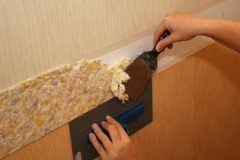Practical recommendations on how to effectively and without consequences remove a stain from paper
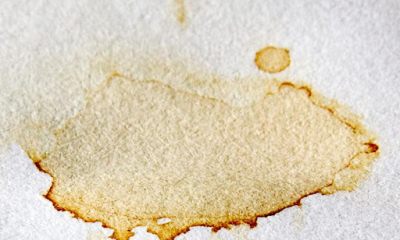 At least once in his life, every person has been faced with the need to clean paper from stains.
At least once in his life, every person has been faced with the need to clean paper from stains.
They can have a different nature of origin, but there is a recipe for each type of pollution.
How to remove a stain of blood, paint, coffee and tea, oil from paper and not spoil it, read the article.
Content
Universal recipes
It is difficult to deal with stains on paper, since the material itself in most cases does not tolerate contact with any liquids. The choice of a tool largely depends on what exactly the sheet was stained with. However, there are also universal substances that can cope with various types of contamination. Top 5 effective recipes:
-
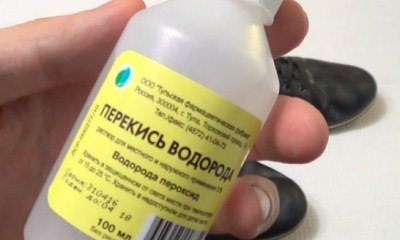 Hydrogen peroxide... With its help, it will be possible not only to remove, but to discolor the stain. For processing, you can use pharmacy peroxide, or purchase 2 tablets of hydroperite, which are dissolved in 50 ml of warm water.
Hydrogen peroxide... With its help, it will be possible not only to remove, but to discolor the stain. For processing, you can use pharmacy peroxide, or purchase 2 tablets of hydroperite, which are dissolved in 50 ml of warm water.A cotton swab is moistened in a liquid and gently work through the contaminated surface from both sides.
A blank sheet is applied above and below so that the document appears to be sandwiched between them. Once dry, the stains will disappear.
- Whitening toothpaste... It perfectly absorbs dirt and discolors the pigment, due to which the stain on the paper is especially noticeable. The paste is applied with a brush in a thin layer and spread evenly over the surface. After 1-2 minutes, remove it with a cotton pad and let the sheet dry. If it was not possible to cope with the pollution the first time, the procedure is repeated.
- Refined gasoline... It acts as a solvent, so it easily removes most types of stains. The only condition is to handle only paper that does not creep when in contact with liquid. Gasoline is applied to a cotton pad, which is gently passed over the entire surface of the stain. If, after cleaning, a greasy residue remains on it, sprinkle it with starch and leave it overnight. In the morning, the powder is peeled off.
- Acetone. For paper processing, it is better to use a nail polish remover, since the concentration of acetone in it is minimal. It is applied to the dirty track with a brush, left for 2-3 minutes, wiped with a damp cotton pad and left to dry.
- Vinegar 9%... The acid can help treat many organic and inorganic stains. It can be used diluted and pure. It all depends on the intensity of the pollution. Vinegar is applied to a cotton pad, applied to a dry leaf for 10 seconds and raised. If the trace disappears immediately, the treatment is stopped. You don't need to rinse off the vinegar, it will dry out and fade on its own.
How to remove contamination from paper using hydrogen peroxide, the video will tell you:
Features of removal of different types of dirt
The choice of a cleaning agent is largely determined by the substance from which the stain appeared on the paper. For example, in order to remove oil traces, first of all, you need to absorb fat, and in the fight against smudges from watercolors, splitting of color pigment comes to the fore.
How to remove the oil trail?
You can get rid of oil traces on paper with the help of such formulations and improvised means as:
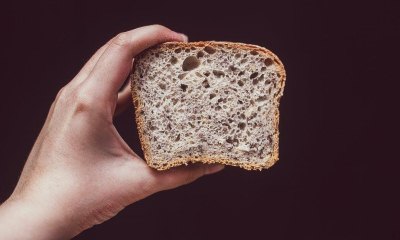 Bread crumb... The crumb of white bread is rolled into a small lump, slightly moistened with warm water and wiped on the contaminated surface until it becomes absolutely clean.
Bread crumb... The crumb of white bread is rolled into a small lump, slightly moistened with warm water and wiped on the contaminated surface until it becomes absolutely clean.- Salt. It is a first aid tool for combating grease stains not only on fabric, but also on paper. The finer the granules are, the better.
Sprinkle the stain with salt, cover it with a clean sheet of paper and iron it with a warm, but not hot iron.
- A piece of chalk. It acts as an absorbent, absorbing grease from any surface. A whole piece is ground into powder with a mortar, sprinkled with a stain and gently rubbed in a circular motion. After 10-20 minutes, shake off the chalk. If the stain remains, then the procedure is repeated, but with the use of an iron.
- Flour. It helps to get rid of fresh traces of fat. It is used by analogy with other bulk substances.
- Turpentine. If a greasy stain has gotten onto strong white paper, you can try to remove it with turpentine, which is applied to a cotton pad and gently wipe the problem area with it.
He will tell you how to remove an oil stain from paper this article.
Watercolor
If the watercolor stain is dry, you can try to dissolve it with water and lemon juice. Procedure:
- add juice squeezed from half a lemon to 100 ml of water;
- pour it into a spray bottle;
- spray the stain, blot it with a clean dry cloth;
- repeat the procedure until complete cleansing.
If splashes of watercolors hit the thick washable wallpaper, then you can deal with them with soapy water. It is prepared on the basis of dishwashing liquid or laundry soap. After treatment, the surface is washed with clean water.
From coffee
Accidentally spilled coffee can ruin not only a school notebook or book, but an important document. To rehabilitate him, they use compounds such as:
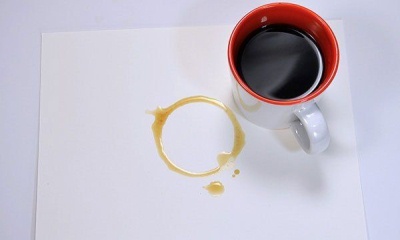 Hydrogen peroxide... She is able to lighten the coffee, making it almost invisible. Apply it with a cotton swab or sponge. After processing, allow the paper to dry naturally.
Hydrogen peroxide... She is able to lighten the coffee, making it almost invisible. Apply it with a cotton swab or sponge. After processing, allow the paper to dry naturally.- Ammonia... They treat the contamination until it disappears completely, after which they wipe the area with a slightly damp cotton swab.
- Bleach. You can use oxygen bleach or Whiteness. Apply them carefully. Only strong, thick and light paper can be processed.
If, in addition to liquid, coffee grounds get on the stain, brush it off before the main treatment.
From dirt
Dirty stains on paper can be removed with the help of such improvised means as:
- Alcohol. They impregnate a cotton pad with which they wipe the problem area several times.
- Hydrogen peroxide... It is used by analogy with alcohol.
- Laundry soap... Before use, it is crushed into shavings and diluted in a small amount of water. The resulting composition is used to treat the contaminated area. When the stain disappears, gently wipe the paper with a damp cloth. This method is suitable for dense material. A thin sheet will not withstand repeated contact with liquid.
Fingerprints
Fingerprints can be removed with hydrogen peroxide... It quickly dissolves various organic impurities. After applying it to the paper will appear. This is a natural reaction that should not be intimidated. When it's over, the fingerprint should be gone.
The ammonia copes well with prints. When working with this substance for the first time, you need to remember that it has a pungent odor, so you need to take care of airing the room in advance.
Soak a cotton swab with ammonia and carefully treat the stain with it. After cleaning, you do not need to rinse off the substance, it will evaporate on its own in a few minutes.
Tea
You can remove a trace of tea with the help of such improvised means as:
 lemon juice - if the paper is strong, it is used in its pure form, a cotton swab is moistened in the juice and the problem area is treated with light blotting movements, excess moisture is removed with a paper napkin;
lemon juice - if the paper is strong, it is used in its pure form, a cotton swab is moistened in the juice and the problem area is treated with light blotting movements, excess moisture is removed with a paper napkin;- ammonia - it makes the dye molecules less durable, so they easily transfer to the processed material;
- if the stain is fresh and has not had time to dry, sprinkle it abundantly with starch, cover it with a clean sheet of paper, pass it over with an iron several times, if necessary, repeat the procedure.
How to remove blood?
Blood is quickly absorbed into the paper and dries up, making it difficult to remove. To cope with the stain will help such compositions as:
- Liquid stain remover, for example, Vanish. They soak a cotton pad with it and touch the stain several times with dipping movements. When the blood begins to pass from paper to sponge, it is changed. You need to work with clean discs so that the stain does not spread and smudge.
- Hydrogen peroxide... It destroys organic molecules, including blood. A few drops of peroxide on a cotton swab are enough to get rid of a little dirt.
- Boiled egg... If the stain is fresh, you can roll it with a warm boiled egg without the shell.
Putty or corrector
The corrector is used to mask ink, but sometimes there are situations when it needs to be removed from the paper. As a rule, this is not difficult to do with the help of substances such as:
- Alcohol. A cotton swab is moistened with it, applied to the stain and kept for about a minute. After such a procedure, the layer of putty can be easily removed with a wooden nail file and even a nail.
- Nail polish remover... It contains a solvent that softens the putty. It is used in the same way as alcohol.
- Glass cleaner... It contains several active ingredients at once that can soften the corrector. A cotton swab is irrigated with liquid, applied to the white trail for 10 seconds (if necessary, the exposure time can be increased). When the putty is soft, remove it with a ruler or toothpick.
No attempt should be made to clean the dry proofreader. Using sharp objects will cause the paper to tear.
Helpful information
Tips that come in handy when removing stains from paper:
 you need to start removing the stain immediately, the longer it stays on the surface of the paper, the deeper it will be absorbed into the structure, it is much more difficult to cope with an old stain than with a fresh one;
you need to start removing the stain immediately, the longer it stays on the surface of the paper, the deeper it will be absorbed into the structure, it is much more difficult to cope with an old stain than with a fresh one;- you need to remove the stain in the direction from the edge to the center, so as not to smear it over the clean areas;
- if it was not possible to cope with the stain the first time, the procedure can be repeated, but only after the paper has dried;
- use a cotton swab to remove small stains; if the pollution is extensive, use a cotton pad;
- in order not to go beyond the boundaries of pollution, they are outlined with wax candles;
- before proceeding with removing a stain from an important document, the selected tool must be tested on a piece of paper similar in structure to the original.
Conclusion
You can remove the stain from the paper with the help of available tools. The main thing is to choose the right composition and use it according to the instructions. The sooner processing starts, the better.


